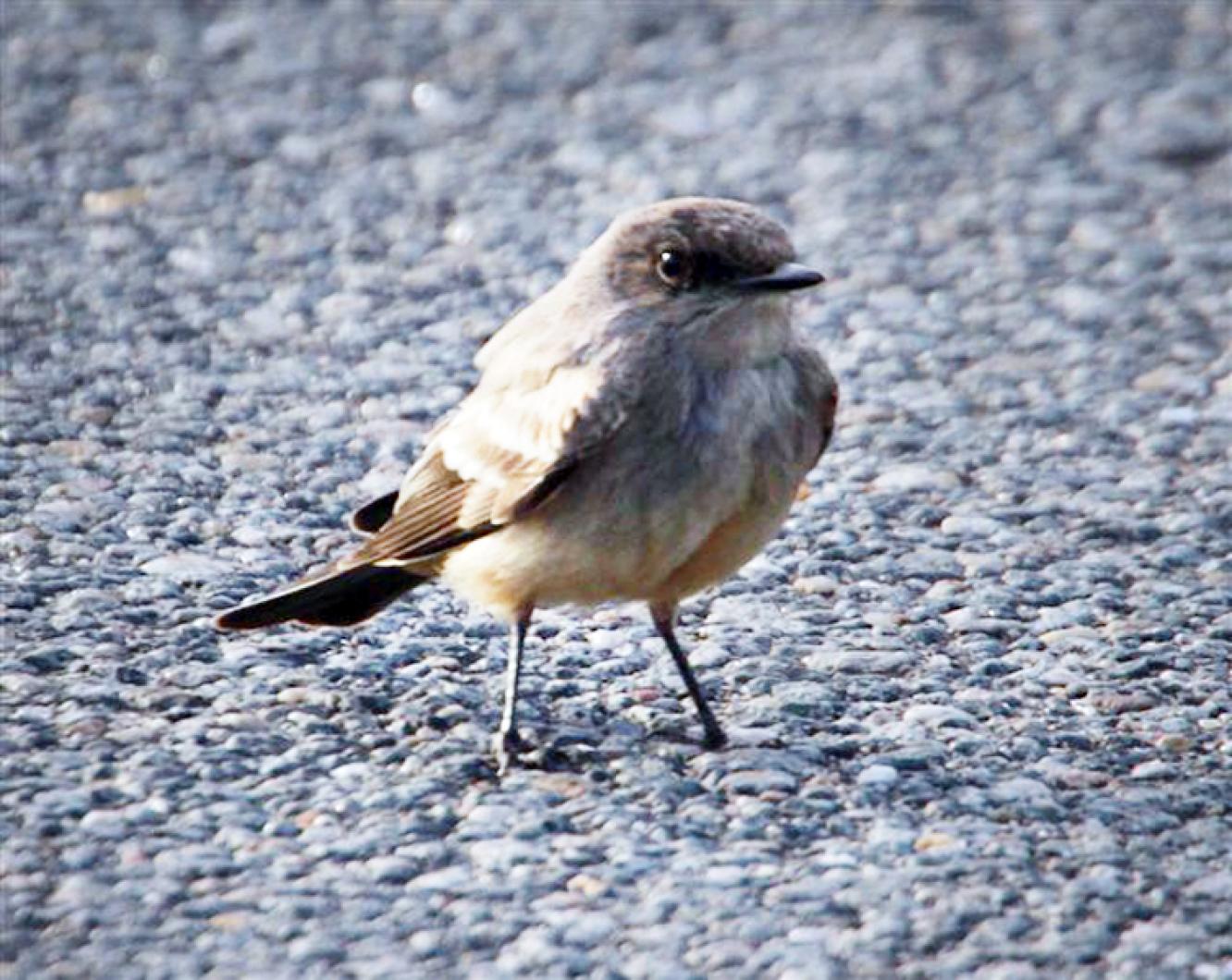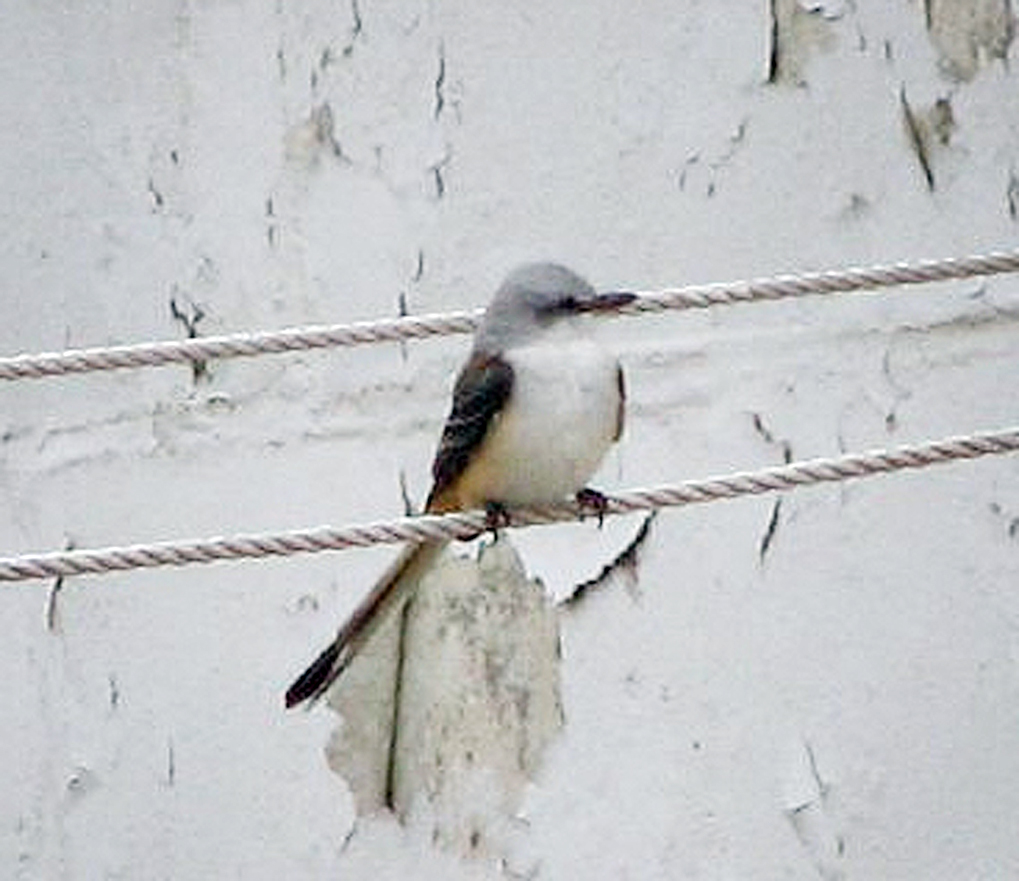Somehow, birds that should not be here sometimes are here. According to the books these birds should be found far away. Then one shows up. The birds, as birders like to comment on occasion, do not read the books.
The last 10 days has delivered three “casual” avian visitors to the Vineyard. A cattle egret dropped in to a pasture at Pimpneymouse Farm on Chappy to keep the equines company. These egrets, which are African in origin, always seem to be looking for ways to expand their presence in the western hemisphere, although the frequency of their appearance in New England seems to have diminished. One or two do show up here or on Nantucket just about every year. The one on Chappy on the 30th was pretty late.
The other two vagrants that dropped in are members of the tyrant flycatcher family: the scissor-tailed flycatcher that was spotted and photographed by Jeff Verner on a rainy and blustery Wednesday, the Oct. 27, near the hospital; and a Say’s Phoebe near the parking spaces and buildings up at the clay cliffs of Aquinnah. Each, so far, has turned out to be a “one-day wonder,” seen for a while and then gone to parts unknown. Another scissor-tailed, or possibly the same one, had been seen by Dave Erickson at Herring Creek on Oct. 11 and later reported to the Gazette office. Attempts by other birders scouring Katama to find it did not produce a sighting.
The Say’s phoebe and the scissor-tailed flycatcher are rare finds of similar status and both would be noteworthy anywhere in New England, or east of the Mississippi for that matter.
At first look, the gorgeous, streamlined and exotically decorated scissor-tailed seems a far cry from the relatively drab and unexceptional Say’s phoebe. Examine the two a bit closer and the two are more similar than not, in structure, habitat preference and feeding behavior, as well as the shared tendency to wander well beyond the typical breeding range. Each likes dry open country, roadways and ranches, and they both sally forth from branches and fence lines to capture insects on the ground or in the air.
The Say’s phoebe has an exceptionally far-ranging breeding range that extends from within Mexico all the way to upper Alaska, which makes it the northernmost nester of all the American flycatchers. On the other hand, the scissor-tailed nests within a more contained area that consists chiefly of Texas and Oklahoma and parts of states contiguous to them to the north and east.
The tyrant flycatcher group includes the empidonax flycatchers, our smallest and hardest to identify flycatchers, the myiarchus flycatchers which include the great crested flycatcher that nests here in the summer woods, the three phoebe species, plus all the kingbirds. If you were to take away the extra length of the scissor-tailed’s exceptional tail feathers, or find a younger one that has not yet grown in the adult’s rectrices (tail feathers), what you have left looks a lot like a western kingbird, which is structurally much like an oversized phoebe.
Something happens after the breeding season that allows a few individuals of each of these two western species to head east in the fall instead of south. That is what happened last week as the birding gods favored the Vineyard by placing both of these related vagrants on our Island outpost within just a few days of each other. The rare visits of the scissor-tailed flycatchers to Massachusetts statewide are more apt to be in the spring or early summer. Of the fall occurrences of record here on the Vineyard, the timing favors November. There are three records for Say’s mentioned in Vineyard Birds II, all of them in September. Since its publication in 2007, I am aware of three more sightings here, including last Saturday’s. The scissor-tailed flycatcher has been recorded on the Island more often, by just a bit, although not as frequently in recent years.
Sightings
It has been an active week for birding. Oct. 27 saw the scissor-tailed flycatcher near the Martha’s Vineyard Hospital. On the Oct. 28, Dierdre DeCarion had a great blue heron at Swamp Cove, Edgartown; Bob Shriber and Allan Keith went to Thimble Farm and picked up four indigo buntings, numerous sparrow species and four palm warblers.
The next day they saw “the” sub-adult bald eagle cruising the cliffs in Aquinnah. Oct. 30 was exciting for Edo and Bob Potter as they sighted the cattle egret in with their horses and Skip Bettencourt took some fine photos; the Say’s phoebe, seen by Lanny McDowell and Bob Shriber, battled stiff winds at the Gay Head cliffs, where there were also many white-crowned sparrows, field sparrows and a lone vesper sparrow which was also seen the next day.
Oct. 31 produced in Oak Bluffs for Katherine Colon and Janet Holladay — white-winged scoters, red-breasted mergansers and six hooded mergansers. That day, at Squibnocket, Allan Keith with Bob Shriber found ruddy ducks, widgeon, a single green-winged teal, two coots, three pied-billed grebes, an American pipit, eastern phoebes and a black-crowned night heron. Later on, Allan sighted 20 green-winged teal and 13 killdeer at Keith Farm.
Nov. 1 brought Donna Honig of Katama white-breasted nuthatches, red-breasted nuthatches as well, a Carolina wren and a flicker to her feeders. On Chappy Allan Keith and yours truly scored a beautiful tundrius peregrine over Poucha Pond, one or two American golden plovers, seven greater yellowlegs, 55 Bonaparte’s gulls, a dozen late tree swallows, a blue-headed vireo, a brown thrasher, maybe 225 yellow-rumped warblers and 17 snow buntings. Heading out to Norton Point solo later on the first Allan had some nice late finds: a couple of Forster’s and common terns, a white-rumped sandpiper and one very late piping plover as well. Mr. Keith birded Aquinnah on Nov. 2 and was treated to a lengthy hawk show featuring upwards of 20 sharp-shinneds, five red-taileds and seven turkey vultures. Many blackbird flocks, some siskins and pipits and somewhere between 750 and 1,000 American robins rounded out his morning. There were also some lingering tree swallows moving through. Remember, this is prime time for spotting cave swallows, so be on the lookout whenever swallows are encountered.
You can report avian sightings to the Bird Hotline is at 508-627-4922 or e-mail to birds@mvgazette.com.
Lanny McDowell is a West Tisbury artist, writer and photographer. Read more about birds and art at LannyMcDowellAvianArt.com, ottgallerymv.com and globalconservationalliance.org .





Comments
Comment policy »